Straw collector
It is used to collect straw into small stacks, or to bring them to a large one. It consists of a collecting platform, left and right handspikes, a frame and a pulley support (Figure 6-2). The collecting platform includes a collecting fork, a side bar and a fence.
Figure 6-2. Straw collector

KEY: 1. Hydraulic arms; 2. Steel cable; 3. Handspike; 4. Frame; 5. Suspension spring; 6. Collecting fork; 7. Side bar; 8. Fence; 9. Supporting frame; 10. Pulley support.
The machine slides forward, with an angle of 5-7° from the ground, to collect straw with the fork. When the fork is full, hydraulic arms are engaged to lift it about 30 cm high from the ground. Then the tractor moves straw to the stack. After lowering the platform, the tractor is backed to unload the straw. There is no stereotype for this machine. Because of its simple structure, users can construct them themselves.
Stacker
There are many types of stacker, including derrick stackers, fan stackers, conveyor belt stackers, slide stackers and hydraulic stackers. For a hydraulic stacker (Figure 6-3), the operation is the following:
(i) the collecting platform is lowered;
(ii) the straw-pushing board (3) is moved back by the hydraulic cylinder (2);
(iii) the collecting fork is used to gather the straw until it is full;
(iv) the large arm (6) lifts it;
(v) a hydraulic cylinder opens cover (1);
(vi) the hydraulic cylinder (2) moves the straw pushing board (3) forward and pushes the straw out.
Figure 6-3. Straw hacker
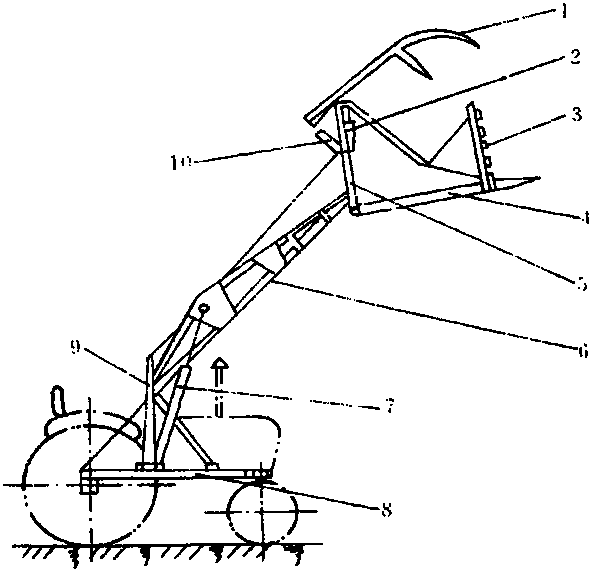
KEY: 1. Cover; 2. Hydraulic piston for pushing straw board; 3. Pushing straw board; 4. Collecting forks; 5. Vertical arms; 6. Large arms; 7. Main hydraulic cylinder; 8. Main frame; 9. Vertical pole; 10. Hydraulic cylinder for cover.
Pick-up-and-press stacker
This consists of a flail-type pick-up chopper, a blower tube with rectangular cross section, a directing cover, a movable top cover, a chamber, a chamber rear door, and a chain conveyor for discharging (Figure 6-4).
The flail type pick-up chopper is used to pick up and chop straw. The airflow, generated by the high-speed rotation of the chopper, blows straw into the chamber through the tube and directing cover. When the chamber is full, the tractor stops moving forward. The top cover is moved down by the compression mechanism to press the straw into the chamber, then the top cover is lifted again. The machine continues to go forward picking up straw again. Generally, a stack can be formed by repeating the above process two or three times. In order to discharge (unload) the stack, the tractor is stopped, the rope is pulled to unlock the chamber's rear door, the hydraulic piston is activated to lift the top cover to its highest position. The chamber's rear door and the top cover open automatically at the same time and the chain conveyor is engaged automatically to move the stack out. When the stack touches the ground, the tractor is driven forward slowly so as to unload the stack on the ground.
Figure 6-4. Pick-up-and-press stacker
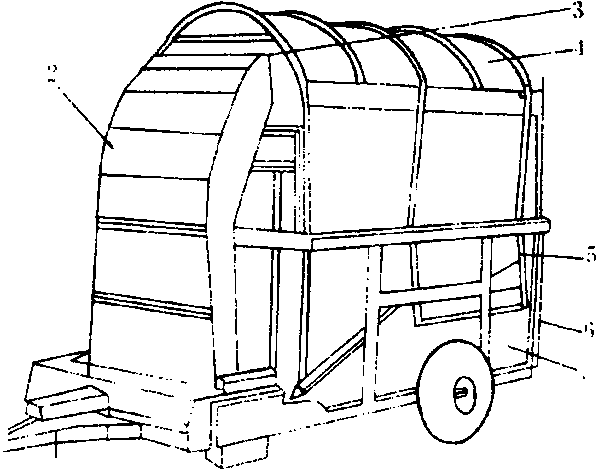
KEY: 1. Flail-type pick-up chopper; 2. Rectangular blower tube; 3. Directing cover; 4. Movable top cover; 5. Compression mechanism; 6. Rear chamber door; 7. Chamber.
The technical parameters of the 9JD-3.6 pickup stacker made in Qiqihaer agricultural and livestock machinery plant are:
|
· Overall dimensions (cm): |
length, 724; width, 398; height, 458.5 |
|
· Net weight: |
4 200 kg |
|
· Chamber volume: |
33 m3 |
|
· Power source: |
44.4-73.5 kW tractor |
|
· Working width: |
198 cm |
|
· Stack dimensions (cm): |
length, 430; width, 260; height, 300 |
|
· Stack weight: |
ca 3 000 kg |
|
· Stack density: |
70-110 kg/m3 |
Stack wagon (stack conveyer)
When the straw stack made by the pick-up-and-press stacker is to be used, it needs to be transported to the feeding site by the stack wagon. The stack wagon (Figure 6-5) is a large platform supported by wheels. On the platform, there are three conveying chains with claws driven by a hydraulic motor fitted at the rear of a pick-up roller and a supporting roller. In operation, the wagon is backed up to the stack. The platform is tilted by the hydraulic cylinder so that the rear roller touches the ground. Then the pickup roller is inserted under the stack. The stack is moved up onto wagon by the combined action of the pickup rollers and reversing of the tractor. When the stack is on the wagon, the platform is returned to the horizontal position and can move off with the stack. After arriving at the feeding site, the platform is tilted again; the chain conveyors are driven in reverse to unload the stack.
Figure 6-5. Stack wagon

KEY: 1. Pick-up roller; 2. Conveying chains with claws; 3. Supporting roller; 4. Large platform; 5. Road wheels; 6. Hydraulic cylinder; 7. Hydraulic motor.
The technical parameters of the 7DY-3.6 stack wagon made in Qiqihaer Agricultural and Livestock Machinery Plant are:
|
Overall dimensions (cm): |
length, 705; width, 277; height, 95 |
|
Overall weight: |
1 200 kg |
|
Power source: |
20 kW from tractor |
|
Carrying capacity: |
3 600 kg |
|
Road speed: |
25 km/hour |
A baler is a machine used to compress hay or straw into bales for easy transport and storage. A bale is the simplest minimum package for marketing.
Balers are divided into stationary balers and field balers. They are further classified into rectangular balers and round balers according to the bale shape produced. According to density of bale, they could be high (200-350 kg/m3), medium (100-200 kg/m3) or low density (<100 kg/m3) balers.
Rectangular pick-up baler
The 9KJ-1.4A rectangular pick-up baler (Figure 6-6), made by the Inner Mongolia Baochang Livestock Machinery Plant, is used as an example for the general structure and function of rectangular pick-up balers. It makes bales from the straw windrow left by the combine. The machine consists principally of a pick-up reel, a conveying and feeding system, a compressing chamber, a bale density adjuster, a bale length controller, a needle-and-tying mechanism, a crank-linkage mechanism, a power transmission, and hauling system.
It is powered from the power take-off (PTO) of the hauling tractor. The straw windrow is lifted from the ground by a pick-up reel having spring teeth (14) and transferred continuously to a conveying and feeding mechanism (3) as the baler moves forward along the windrow. The conveying and feeding mechanism (3) pushes individual charges of hay into the bale chamber (6) from the side at intervals when the piston (2) is withdrawn. The piston reciprocates under the function of the crank-linkage mechanism to press the material into the bale. When the bale reaches the required length, the needle-and-tying mechanism is engaged automatically to bind the bale, which is then pushed out from the chamber by successive bales and is discharged to the ground.
Rectangular bales can be lifted and loaded either by hand or by a loading machine mounted on the side of a truck or trailer and driven by a ground wheel. The Jilin Baicheng Agricultural and Livestock Machinery Factory also make this kind of baler, model 9JKC-2.7.
Figure 6-6. Structure and operation of a 9KJ-1.4A baler
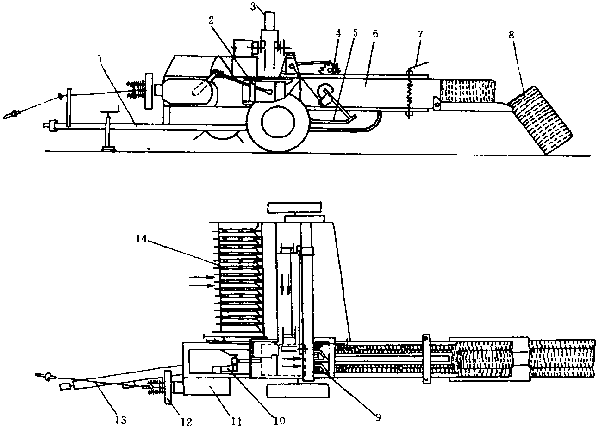
KEY: 1. Tow beam; 2. Piston; 3. Conveying and feeding equipment; 4. Bale length controller; 5. Needles; 6. Compression chamber (bale chamber); 7. Bale density adjuster; 8. Bale; 9. Needle-and-tying mechanism; 10. Crank; 11. Main gear box; 12. Flywheel; 13. Universal joint gearing axis; 14. Pick-up reel.
Basic specifications of the 9KJ-1.4A rectangular baler:
|
· Overall dimension (cm): |
length, 480; width, 270; height, 145 |
|
· Power source: |
22 kW from tractor PTO |
|
· Working speed and output: |
5 km/hour; 5 000 - 7 000 kg/hour |
|
· Piston frequency: |
70-80 strokes per minute |
|
· Feed rate: |
1.5-2.5 kg per cycle |
|
· Nominal pick-up width: |
141.4 cm |
|
· Working width: |
160 cm |
|
· Bale size (cm): |
Length, 60-120; width, 46; height, 36 |
|
· Bale weight and density: |
15-25 kg; 100-180 kg/m3 |
|
· Baler net weight: |
1 480 kg |
High density baler
The 92FY-300 high density baler (Figure 6-7) manufactured by the Inner Mongolia Yakeshi Forestry Machinery Plant is taken as an example to describe basic structure and working process. It is a stationary baler equipped with front and rear wheels. It can be hauled to the working site by a tractor. The density of the bale reaches 300 kg/m3. An electric or diesel motor or the tractor's PTO can supply the power (17 kW). A belt, a chain and a gear by a linkage mechanism drive an eccentric axis that moves the piston back-and-forth. At the same time, the conveying mechanism moves up-and-down to feed the straw into the compression chamber. The bales are fastened with three steel wires (diameter, 2 mm; length, 210 cm).
Basic specifications are:
|
· Overall baler dimensions (cm): |
length, 77; width, 150; height, 254 |
|
· Net weight of the baler: |
4 tonne. |
|
· Bale size (cm): |
length, 50-65; width, 36; height, 46 |
|
· Bale weight: |
30-35 kg. |
|
· Piston displacement; |
62 cm |
|
· Piston frequency: |
30 times per minute |
|
· Output: |
50-80 bales per hour |
|
· Reference price: |
¥ 35 000 |
Figure 6-7. High density baler
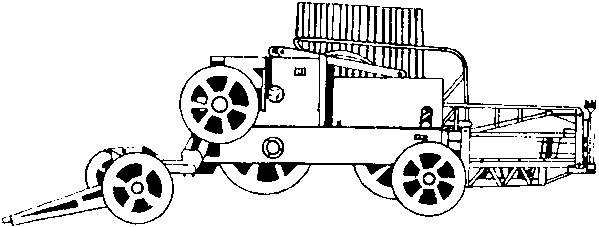
Round baler
The round baler is a new kind of pickup baler. The bales are round, 90-200 cm in diameter. It has the advantages of simple structure and convenience for adjusting and use. The round bales resist the rain, are convenient for feeding and adapted to outside storage. They also save on wire. As a result, they are being increasingly used.
Based on the form of working unit, round balers can be classified into long-belt type, short-belt type, chain type and roller type. They are also classified into inside winding type and outside winding type by their working principle. Long-belt and chain types are inside winding; short-belt and roller types are outside winding.
Figure 6-8 illustrates a belt, inside winding pick-up baler that consists of a pick-up reel, a conveying and feeding mechanism, a wrapping and pressing mechanism, a rear door for unloading, a transmission mechanism and a hydraulic operating mechanism. Its working process is shown in Figure 6-9. The windrow is lifted by a pickup reel (4) and rolled up to double smooth rollers (3) where it is pressed into a flat layer, then conveyed to the baler chamber. With the upper belt the straw moves upward by friction to a certain height, then rolls down to the lower belt by gravity to form the core of the bale, which continually rolls, increasing the diameter. When the bale reaches the desired size it is discharged from the lower belt. The springs fixed in the swing arms in the two sides of the bale chamber maintain the pressure of the belt on the bale's surface. The pressure increases with bale size, resulting in low density on the inside of the bale but high density on the outside. Inside wrapping means that the volume of the wrapping and pressing chamber enlarges during pressing to keep a constant pressure on the bale. The bales formed by inside wrapping have much higher density than by outside wrapping and keep their shape for longer during storage. However, the structure of an inside wrapping baler is more complicated. When the bale reaches the desired size, an indicator alerts the driver to engage the hydraulic distributor in order to activate the binding mechanism. The twine is passed by the tube and fed with straw to the chamber. The twine is wrapped around the circumference of the bale, then cut by a blade. The rear door is lifted hydraulically. The bale is then discharged to the ground.
Figure 6-8. Inside wrapping pick-up round baler
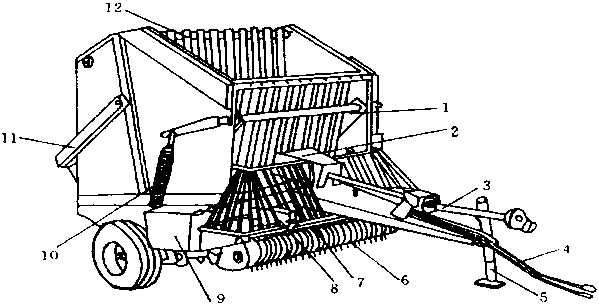
KEY: 1. Swing arms; 2. Gear box; 3. Gearing shaft; 4. Hydraulic power supply tube; 5. Support frame; 6. Pick-up reel; 7. Tube for the twine; 8. Twine cutter; 9. Twine box; 10. Tension spring; 11. Rear discharge door; 12. Belt of wrapping and pressing chamber.
Figure 6-9. Operating principle of the wrapping and pressing mechanism

STAGES: A. Forming of the core of the bale. B. Making the bale. C. Discharging the bale KEY: 1. Upper belt; 2. Swing arms; 3. Smooth rollers; 4. Pick-up reel; 5. Road wheels; 6. Rear door for discharging; 7. Hydraulic cylinder; 8. Side walls.
The round baler manufactured by the Jilin Baicheng Agricultural and Livestock Machinery Plant belongs to this type. Its specifications are:
|
· Overall dimensions (cm): |
length, 485; width, 245, height, 243 |
|
· Net weight: |
1 900 kg |
|
· Power source: |
40.4 kW from tractor hydraulic system |
|
· Working speed and output: |
5 km/hour; 8-12 bale/hour |
|
· Bale weight: |
450-500 kg |
|
· Bale diameter and width: |
180 cm; 150 cm |
|
· Width of pick-up: |
140 cm |
Round bales must be loaded, transported and unloaded by machine due to their heavy weight. The 7KY-4 round bale transporting wagon made in China is hydraulically driven and equipped with an automatic pickup mechanism. It can pickup and load round bales with flexibility and accuracy. Four bales can be transported simultaneously.
Several new cultivars of maize have been popularized in large areas of China, and some of these cultivars have a green stalk at harvest, so they are fit for ensiling. Stover can be harvested, chopped and loaded by a long-stalk cutting platform fitted to a silage harvester (also called a silage combine), and then put into the silo. The 9SQ-10 cylinder-type forage harvester made by the Chifeng Livestock Machinery Plant belongs to this type. When the machine is equipped with a long-stalk cutting platform, its parameters are as follows:
|
· Dimensions (cm): |
length, 620; width, 310; height, 288.6 |
|
|
· Weight: |
1 180 kg; |
|
|
· Power supply: |
40.4-58.8 kW from tractor |
|
|
· Cylindrical chopping device: |
|
|
|
|
cylinder rotation speed: |
1 120 rpm; |
|
|
cutting blades: |
6 |
|
|
harvesting rows: |
2 |
|
|
distance between rows: |
60 or 70 cm |
|
|
stalk cutter: |
double disc-type |
The Beijing Combine Factory has designed a self-propelled maize harvester (model 4YZ-4) that accomplishes picking, husking, ear collecting, stover and leaf chopping, and returning to the ground or throwing into a trailer as a single-pass operation. It is well suited to harvest maize before sowing wheat. It harvests four 70-cm rows with an efficiency of 1-2.5 ha/hour. The engine power is 110.25 kW, and its weight is 9 tonne. The reference price is ¥ 150 000.
Figure 6-10. Cylinder-type silage harvester with thrower
